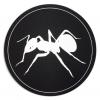Alright, since we have no idea what spp. are in your area, I'm gonna give you as much info on this as I possibly can for you to be able to figure things out yourself 
Generally speaking, it needs to be at least 68-70F for ants to consider flying. There are exceptions to this rule, but the vastttt majority of ants comply with it in a place like NYC especially.
Rain does trigger ant flights to some extent but it's not as important in a place like NYC as it is in the more arid climates. Many ants can and will fly days or weeks after the last rainfall.
Here is some general info on spp. I expect to be quite common in your area:
Camponotus pennsylvanicus and the species similar to them will fly roughly at nightfall a little bit farther into the warm season. Probably early May or very late April is when you'll see the heaviest flights from them. They fly all year in tiny quantities, but 95%+ of the queens fly at that time. The Camponotus species in the subgenus Myrmentoma, seem to fly roughly 1 week give or take before their larger cousins. Although, with that in mind, I have caught them alongside the other Camponotus spp.
Tetramorium immigrans is one of the most abundant ants in the urban and surbaban environment for the majority of the temperate United States. They will typically fly sometime between June and August, and will most abundantly fly in July. In the very extreme I have seen them fly in May and September but I would guess that's quite rare. They fly at the break of dawn. I watch for days where the temperature is going to be ~68F+ at dawn, and then check on the colonies outside at like 1-3am. They will begin posting up with alates and widening the nest entrance so you can tell when they're gonna fly in the morning at dawn. These guys will have many, many flight days throughout the season so if you miss a few, don't worry about it. One last thing to mention, it seems like randomly in some areas this species will fly in the late afternoon. It's always a much smaller flight than the ones at dawn, but it does happen  .
.
That's probably enough to get you started. As you figure out what is in your area, you can start to figure out when they fly and be ready for them. Also, keep in mind, there will be spp. having nuptial flights in your area that you don't see out and about. They might be active when you're not, the colonies might be in areas you don't/can't visit, or they might be cryptic and very hard to notice. Typically speaking, while it is useful to know what you're hunting for, it's kind of a numbers game. Just try to spend as much time keeping an eye out for queens and eventually more and more will fall into your lap.
Currently Keeping:
Trachymyrmex septentrionalis
Pheidole pilifera
Forelius sp. (Monogynous, bicolored) "Midwestern Forelius"
Crematogaster cerasi
Pheidole bicarinata
Aphaenogaster rudis
Camponotus chromaiodes
Formica sp. (microgena species)
Nylanderia cf. arenivega





















